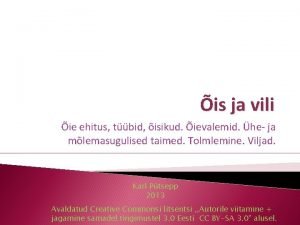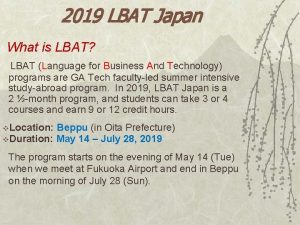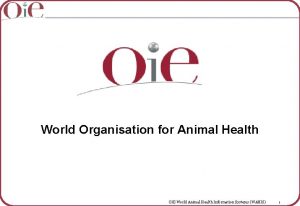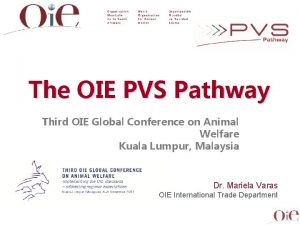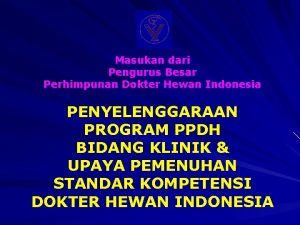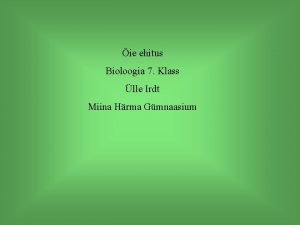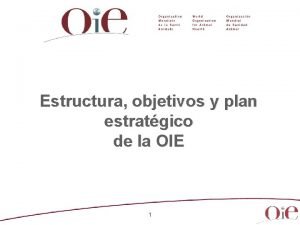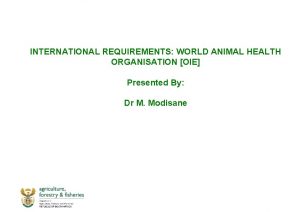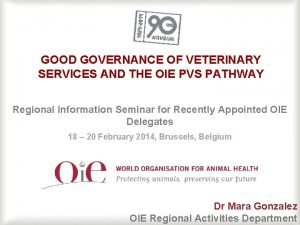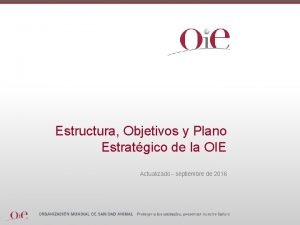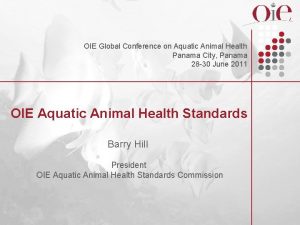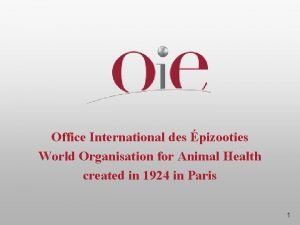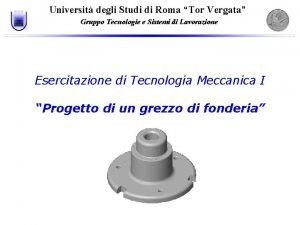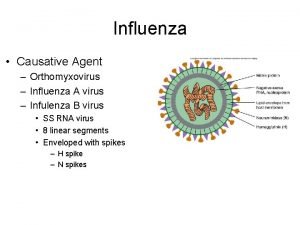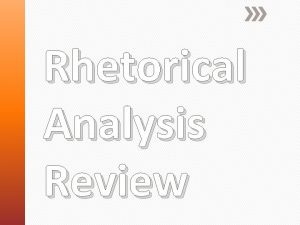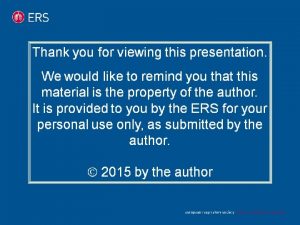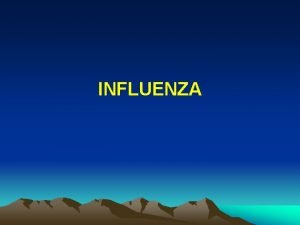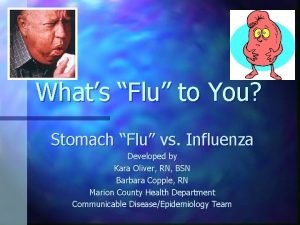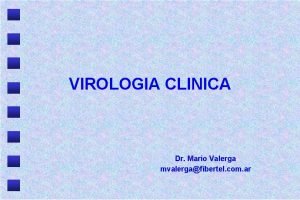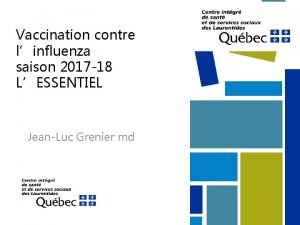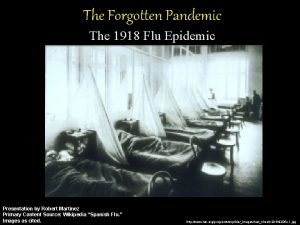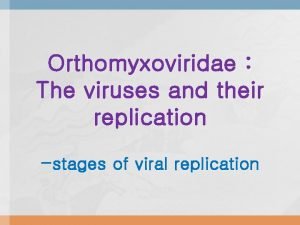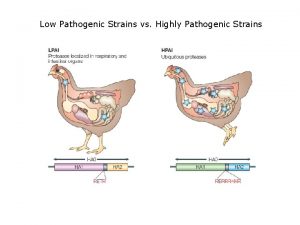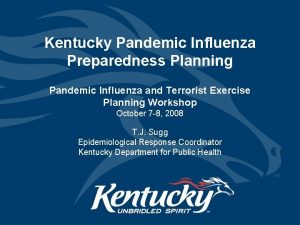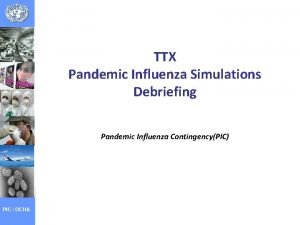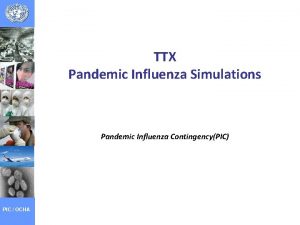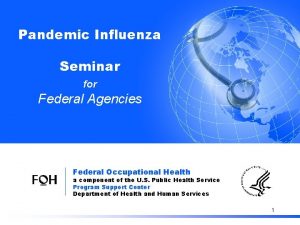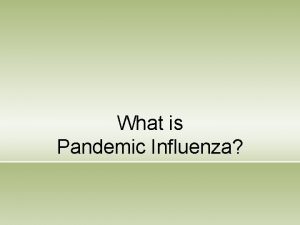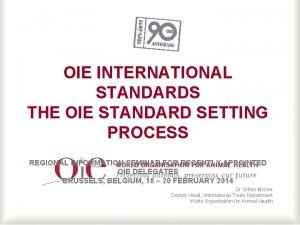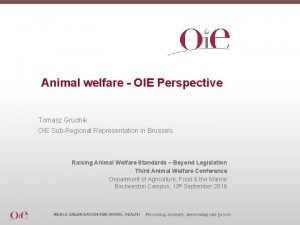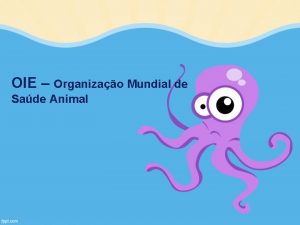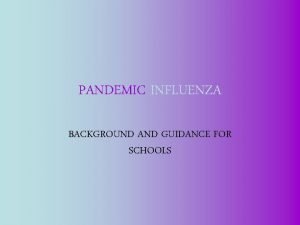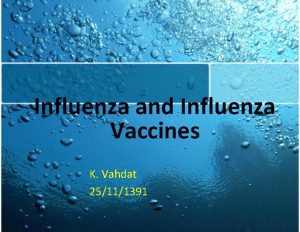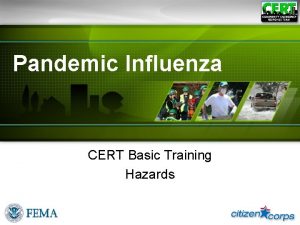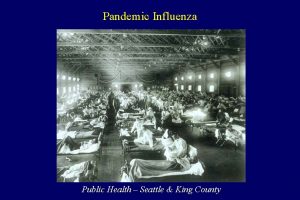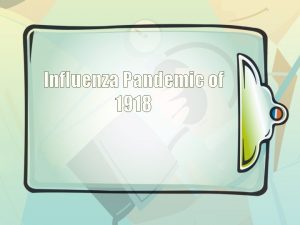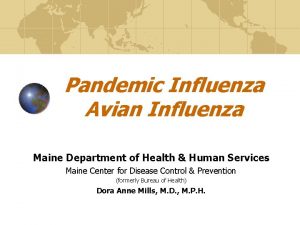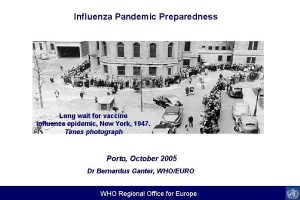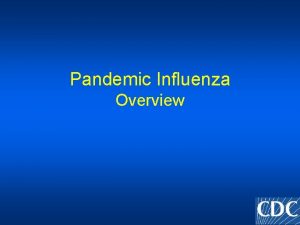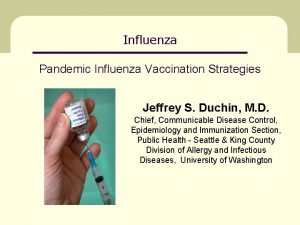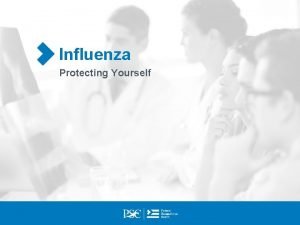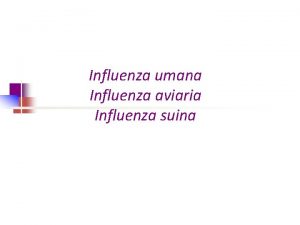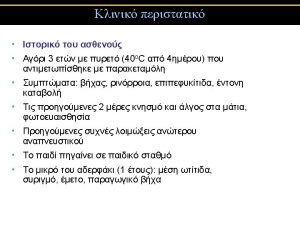OIE Influenza Standards and Communication on Pandemic H































- Slides: 31

OIE Influenza Standards and Communication on Pandemic (H 1 N 1) 2009 AVIAN INFLUENZA: INTERSECTORAL COLLABORATION Larnaca, Cyprus 20 – 22 July 2009 Kate Glynn DVM, MPVM Scientific and Technical Department

• • WORLD ORGANISATION FOR ANIMAL HEALTH (OIE) An intergovernmental organisation Founded in 1924 174 Members (In June 2009) Headquarters in Paris, France • 5 Regional offices • 4 Regional sub offices • Mandate : “to improve Animal Health worldwide” 52 13 13 29 51 29

OIE Standards

Animal Health Standards - OIE Major Texts for Terrestrial Animals • Terrestrial Animal Health Code (Terrestrial Code) http: //www. oie. int/eng/normes/mcode/en_sommaire. htm • Manual of Diagnostic Tests and Vaccines for Terrestrial Animals (Terrestrial Manual) http: //www. oie. int/eng/normes/mmanual/A_summry. htm • OIE Principles – Guidance, Standards, Transparency

Terrestrial Animal Health Code Structure • Volume 1 – cross-cutting, 'horizontal standards' • Volume 2 – disease-specific, 'vertical standards' The value of the Terrestrial Code is twofold • represents consensus among the veterinary authorities of OIE Members • constitutes a reference within the World Trade Organization Agreement on the Application of Sanitary and Phytosanitary Measures as an international standard for animal health and zoonoses

Terrestrial Manual • Principal target readership - laboratories carrying out veterinary diagnostic tests and surveillance, plus vaccine manufacturers and regulatory authorities in Member Countries • Objective - to provide internationally agreed diagnostic laboratory methods and requirements for the production and control of vaccines and other biological products

Notification and Reporting • Chapter 1. 1. Notification of diseases and epidemiological information • Members shall…. . • Built upon a framework of a competent veterinary services and effective surveillance program

Criteria for Listing a Disease INTERNATIONAL SPREAD? NO EMERGING? YES ZOONOTIC POTENTIAL? NO SIGNIFICANT SPREAD IN NAIVE POPULATIONS? YES EXCLUDE INCLUDE NO YES EXCLUDE INCLUDE

OIE Listed Diseases Multiple species diseases: Avian diseases: • • • • • • • • • Anthrax Aujeszky's disease Bluetongue Brucellosis (B. abortus/melitensis/suis) Crimean Congo haemorrhagic fever Echinococcosis/hydatidosis Epizootic haemorrhagic disease Equine encephalomyelitis (Eastern) Foot and mouth disease Heartwater Japanese encephalitis Leptospirosis New world screwworm (Cochliomyia hominivorax) Old world screwworm (Chrysomya bezziana) Paratuberculosis Q fever Rabies Rift Valley fever Rinderpest Surra (Trypanosoma evansi) Trichinellosis Tularemia Vesicular stomatitis West Nile fever • • • Avian chlamydiosis Avian infectious bronchitis Avian infectious laryngotracheitis Avian mycoplasmosis (Mycoplasma gallisepticum) Avian mycoplasmosis (Mycoplasma synoviae) Duck virus hepatitis Fowl cholera Fowl typhoid Highly pathogenic avian influenza in birds and low pathogenicity notifiable avian influenza in poultry as defined in Chapter 10. 4. Infectious bursal disease (Gumboro disease) Marek's disease Newcastle disease Pullorum disease Turkey rhinotracheitis

Notification Procedures Types of Reports • Immediate notification of disease, infection or unusual epidemiological events • Weekly reports: Follow-up to the immediate notification • Final report: • if the outbreaks have ended (event closed) • if the situation becomes endemic • Six-monthly report • Annual report

Emerging Disease • … a new infection resulting from the evolution or change of an existing pathogenic agent, a known infection spreading to a new geographic area or population, or a previously unrecognized pathogenic agent or disease diagnosed for the first time and which has a significant impact on animal or public health

Avian Influenza – Terrestrial Code «Highly pathogenic avian influenza in birds and low pathogenicity notifiable avian influenza in poultry» (http: //www. oie. int/eng/normes/mcode/en_chapitre_1. 10. 4. htm) For the purposes of international trade, • Notifiable avian influenza (NAI) - an infection of poultry caused by any influenza A virus of the H 5 or H 7 subtypes or by any AI virus with an intravenous pathogenicity index (IVPI) greater than 1. 2 (or as an alternative at least 75% mortality) as described below. • highly pathogenic notifiable avian influenza (HPNAI) • low pathogenicity notifiable avian influenza (LPNAI)

Avian Influenza – Terrestrial Code For the purposes of international trade, • HPNAI vs LPNAI • HPNAI viruses have an IVPI in 6 -week-old chickens greater than 1. 2 or, as an alternative, cause at least 75% mortality in 4 -to 8 week-old chickens infected intravenously. • H 5 and H 7 viruses which do not have an IVPI of greater than 1. 2 or cause less than 75% mortality in an intravenous lethality test should be sequenced to determine whether multiple basic amino acids are present at the cleavage site of the haemagglutinin molecule (HA 0); if the amino acid motif is similar to that observed for other HPNAI isolates, the isolate being tested should be considered as HPNAI; • LPNAI are all influenza A viruses of H 5 and H 7 subtype that are not HPNAI viruses.

What Is “Poultry”? • Poultry is defined as ‘all domesticated birds, including backyard poultry, used for the production of meat or eggs for consumption, for the production of other commercial products, for restocking supplies of game, or for breeding these categories of birds, as well as fighting cocks used for any purpose’. • Birds that are kept in captivity for any reason other than those reasons referred to in the preceding paragraph, including those that are kept for shows, races, exhibitions, competitions or for breeding or selling these categories of birds as well as pet birds, are not considered to be poultry.

• Avian Influenza – Terrestrial Manual Diagnostic tests 1) Identification of the agent (the prescribed test for international trade) 2) Assessment of pathogenicity 3) Serological tests 1) Agar gel immunodiffusion 2) Haemagglutination and haemagglutination inhibition tests 4) Antigen capture and molecular techniques 1) Antigen detection 2) Direct RNA detection • Safe, effective, potent vaccine development, DIVA strategy, and post-vaccination monitoring http: //www. oie. int/eng/normes/mmanual/2008/pdf/2. 03. 04_AI. pdf

OIE Communications on Pandemic (H 1 N 1) 2009

Number of cases Laboratory Confirmed Pandemic (H 1 N 1) 2009 Cases among Humans, by Date Reported to WHO Outbreak of respiratory illness, Mexico 2 cases new A/H 1 N 1, USA; 1 case atypical pneumonia, Mexico and USA cases = same strain April Date Reported to WHOMay www. who. int, As of 22 May 2009

Number of cases Laboratory Confirmed Pandemic (H 1 N 1) 2009 Cases among Humans, by Date Reported to WHO July 6 Testing Changes June 11, Pandemic Phase 6 29 April Pandemic Phase 5 27 April Pandemic Phase 4 April May June July www. who. int, As of 6 July 2009

“April 27 – A/H 1 N 1 influenza like human illness” • Not justified to name this human disease swine influenza • Now called “Pandemic (H 1 N 1) 2009”

Background Influenza A in Swine • Respiratory illness described in pigs in 1918 – believed to be the first occurrence of influenza in swine • “Classical” swine influenza • Swine influenza virus first isolated in 1930 as H 1 N 1 • Swine influenza endemic in many pig populations • Pigs can be infected with different influenza viruses “reassortant strains” • Currently - various “avian-like”, reassortant, or triple reassortant influenza viruses circulating among swine populations • Swine influenza is not an OIE listed disease

Why “Classical” Swine Influenza Is Not an OIE Listed Disease • It does not meet the criteria outline in the Terrestrial Code (Chapter 1. 2) of the Terrestrial Code. • While swine influenza is capable of rapidly spreading within a herd, it is predominantly a production diseases with very low mortality. • Human infection with the known swine influenza viruses has been an uncommonly described event and is clinically similar to seasonal influenza. • Note – Occurrence of pandemic (H 1 N 1) 2009 in pigs is currently reportable to the OIE under the qualification of an emerging disease

OIE Statements Related to Pandemic (H 1 N 1) 2009 • A/H 1 N 1 influenza like human illness in Mexico and the USA: OIE statement (27 -Apr) • OIE position on safety of international trade of pigs and products of pig origin (28 -Apr) • The OIE strongly counsels against the culling of pigs (30 -Apr) • Joint FAO/WHO/OIE Statement on influenza A(H 1 N 1) and the safety of pork (30 -Apr, reissued 7 -May)

First Report of Pandemic (H 1 N 1) 2009 Virus in Swine 2 -May: One swine herd in tested positive for influenza A H 1 N 1 virus, later confirmed as pandemic (H 1 N 1) 2009 strain Based on available epidemiologic information - it is believed that the pigs were exposed to the virus from a human with influenza-like symptoms Immediate quarantine of herd and notification by Canada to OIE as an “Emerging Disease”

OIE Statements Related to Pandemic (H 1 N 1) 2009 • OIE comments on the findings of “A/H 1 N 1” in pigs in Canada (4 -May) • OIE reaction to trade restrictions imposed following transmission of virus “A/H 1 N 1” from human to pigs (7 -May) • The OIE advocates implementing international standards for humane killing of animals for disease prevention purposes (20 -May) • Novel influenza A/H 1 N 1 pandemic: the OIE maintains its recommendations to animal health authorities worldwide (11 -June)

13 July: Pandemic H 1 N 1 2009

OFFLU OIE-FAO Network of Expertise on Animal Influenza • Established initially as the joint OIE-FAO network of expertise on avian influenza in 2005 • to exchange scientific data and biological materials (including virus strains) within the network, to analyse such data, and to share such information with the wider scientific community. • to offer technical advice and veterinary expertise to Member Countries to assist in the prevention, diagnosis, surveillance and control of avian influenza • to collaborate with the WHO influenza network on issues relating to the animal-human interface, including early preparation of human vaccine • to highlight avian influenza research needs, promote their development and ensure co-ordination.

OFFLU • OFFLU strengthens links within our animal health network and collaborates with the existing WHO influenza network on all matters relevant to public health • http: //www. offlu. net/ • Expanded mandate to “animal influenza” in response to pandemic (H 1 N 1) 2009 • Drawing upon existing swine influenza expertise • Incorporating new swine influenza expertise

OFFLU Actions in Response to Emergence of Pandemic (H 1 N 1) 2009 • Technical consultations • human–animal interface aspects of the current influenza A (H 1 N 1) situation (WHO-OFFLU) • laboratory diagnosis of new A/H 1 N 1 in swine (OFFLU-WHO) • proposed origin of novel influenza A H 1 N 1 virus (WHO-OFFLU) • surveillance issues around new influenza A/H 1 N 1 and the human animal interface (OFFLU-WHO)


Remaining Issues Regarding Pandemic (H 1 N 1) 2009 Strain for OIE • It is likely that the circulation of this virus among humans lead to more pig infections and/or illness • It appears that infection of pigs with this new virus causes disease similar to “classical” swine influenza • Can we prevent this new influenza from becoming established in the pig population? • Do existing pig SIV vaccines provide cross-protection against this new strain? • What may be the implications for disease reporting?

Thank you for your attention k. glynn@oie. int Organisation Mondiale de la Santé Animale World Organisation for Animal Health Organización Mundial de Sanidad Animal 12 rue de Prony, 75017 Paris, France - www. oie. int – oie@oie. int
 Covid 19 pandemic summary
Covid 19 pandemic summary Interpandemic period
Interpandemic period Pandemic tabletop exercise template
Pandemic tabletop exercise template Mathalicious pandemic answer key
Mathalicious pandemic answer key Who pip framework
Who pip framework Tuultolmlejad
Tuultolmlejad Oie gatech
Oie gatech Oie
Oie Oie pvs tool
Oie pvs tool Oie delegates
Oie delegates 33 profesi dokter hewan menurut oie
33 profesi dokter hewan menurut oie õiepõhi
õiepõhi Nombres de las banderas en ingles
Nombres de las banderas en ingles Oie
Oie Oie
Oie Oie
Oie Objetivos de la oie
Objetivos de la oie Oie aquatic animal health code
Oie aquatic animal health code Oie office international des epizooties
Oie office international des epizooties Modulo termico materozza
Modulo termico materozza The causative agent of influenza
The causative agent of influenza The great influenza rhetorical analysis essay
The great influenza rhetorical analysis essay Olfactory mucosa
Olfactory mucosa Influenza
Influenza Stomach flu vs influenza
Stomach flu vs influenza Is influenza a airborne disease
Is influenza a airborne disease Virus de la influenza
Virus de la influenza Influenza vaccine dosage chart 2019-2020
Influenza vaccine dosage chart 2019-2020 Influenza ww1
Influenza ww1 Influenza virus replication
Influenza virus replication Low pathogenic avian influenza
Low pathogenic avian influenza Hard customer defined standards
Hard customer defined standards





